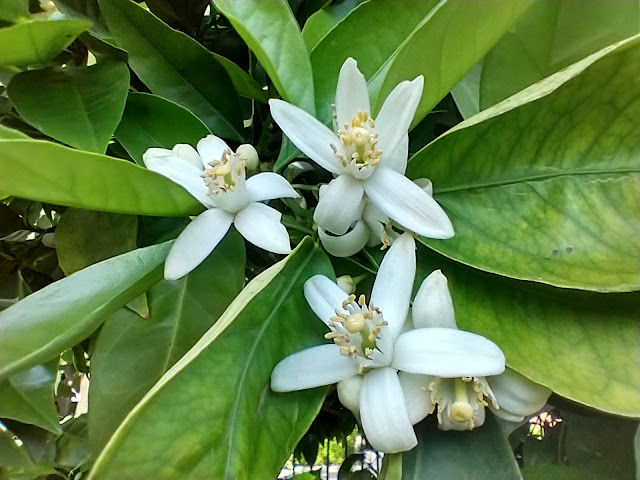
Rain coming soon -- but how much?

|
|
Orange trees are blooming, including this one in Midtown Sacramento. The blossoms are a reminder to give the trees a low dose of balanced fertilizer. (Photo:
Debbie Arrington)
|
Sacramento can (finally) expect more rain Monday, maybe even Sunday evening. But how much?
According to the National Weather Service, estimates are just that – estimates. This fast-moving storm system could drop as much as an inch of rain on Sacramento – or just 0.10.
Most likely, it will be somewhere in between those amounts. As of late Friday night, the weather service pegs Sacramento's total at 0.62 inches with “definite rain showers and thunderstorms” forecast throughout Monday.
Otherwise, our final days of March will stay mostly on the warm side with afternoons in the mid 70s while overnight lows will keep dipping into the 40s.
Expect more of the same for at least a little while. April in Sacramento averages highs of 71 degrees and lows of 46.
* Smell orange blossoms? Feed citrus trees with a low dose of balanced fertilizer (such as 10-10-10) during bloom to help set fruit. Keep an eye out for ants.
* Early spring is the last chance to plant citrus trees such as dwarf orange, lemon and kumquat. These trees also look good in landscaping and provide fresh fruit in winter.
* Apply slow-release fertilizer to the lawn.
* Watch out for powdery mildew and other fungal diseases.
* Knock aphids off plants with a strong blast of water.
* Thoroughly clean debris from the bottom of outdoor ponds or fountains.
* Spring brings a flush of rapid growth, and that means your garden is really hungry. Feed shrubs and trees with a slow-release fertilizer. Or mulch with a 1-inch layer of compost.
* Azaleas and camellias looking a little yellow? If leaves are turning yellow between the veins, give them a boost with chelated iron.
* Trim dead flowers but not leaves from spring-flowering bulbs such as daffodils and tulips. Those leaves gather energy to create next year's flowers. Also, give the bulbs a fertilizer boost after bloom.
* Transplant lettuce and cabbage seedlings.
* Gradually expose tomato and pepper seedlings to outdoor conditions, starting with a few hours in morning sun. As soil warms, these "hardened off" transplants can go in the ground.
* From seed, plant beets, carrots, chard, chives, fennel, mustard, radishes, squash and turnips. Plant seed potatoes.
* In the flower garden, plant seeds for asters, cosmos, celosia, marigolds, salvia and sunflowers.
* Transplant petunias, geraniums and other summer bloomers.
* Plant perennials and dahlia tubers for summer bloom.
Comments
0 comments have been posted.Sacramento Digs Gardening to your inbox.
Sites We Like
Garden Checklist for week of May 5
Survey your garden after the May 4 rainstorm. Heavy rain and gusty winds can break the neck of large flowers such as roses. Also:
* Keep an eye on new transplants or seedlings; they could take a pounding from the rain.
* Watch out for powdery mildew. Warmth following moist conditions can cause this fungal disease to “bloom,” too. If you see a leaf that looks like it’s dusted with powdered sugar, snip it off.
* After the storm, start setting out tomato transplants, but wait on the peppers and eggplants (they want warmer nights). Pinch off any flowers on new transplants to make them concentrate on establishing roots instead of setting premature fruit.
* Trim dead flowers but not leaves from spring-flowering bulbs such as daffodils and tulips. Those leaves gather energy to create next year's flowers. Also, give the bulbs a fertilizer boost after bloom.
* Pinch chrysanthemums back to 12 inches for fall flowers. Cut old stems to the ground.
* Mulch around plants to conserve moisture and control weeds.
* From seed, plant beans, beets, cantaloupes, carrots, corn, cucumbers, melons, pumpkins, radishes and squash.
* Plant onion sets.
* In the flower garden, plant seeds for asters, cosmos, celosia, marigolds, salvia, sunflowers and zinnias. Transplant petunias, zinnias, geraniums and other summer bloomers.
* Plant perennials and dahlia tubers for summer bloom.
* Don’t wait; plant summer bulbs, such as gladiolus and tuberous begonias.
* Harvest cabbage, lettuce, peas and green onions.